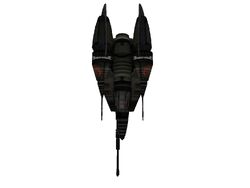The CB/I-17 2 MkII, typically referred to as simply the Vev Fighter was a starfighter designed by VMEW and produced by Ikest Industries during the RLF-Imperial War. It was renowned for its service under the Republic Liberation Forces during the war, and after the creation of the People's Galactic Alliance.
The Vev was a hit-and-run fighter, and this tactic epitomized the unconventional, guerilla nature of the RLF, and the risks involved ensured that only the most daring pilots were willing to fly the fighter. Because Vev operations relied on intense but brief and piecemeal application of force, it was not well known despite becoming ubiquitous by the end of the RLF-Imperial War and well into the years of the People's Galactic Alliance, and it was regarded as the most undersung of the RLF and PGA's fighters. However, this combination of traits has been recognized to embody the tenacious fighting spirit of the RLF itself, and so the Vev enjoys the loosest aesthetic regulations. Vev pilots are known to adorn their fighters with firaza teeth, kill count markings, and other customization, and the Vev bears the distinction of being the sole fighter emblazoned with the modified Nova Hawk of the RLF.
Characteristics[]

The MkIIA configuration of the CB/I-17 is where it derives its nickname, Vev, after the Y-shaped Aurebesh character.
The Vev was a stout, rounded fighter, designed from the start to have extremely high power requirements to supply large-yield weapons, while still retaining a high maximum acceleration. Minimal shielding and thin armor, a result of the power drain by other systems and the sheer degree of space that the power plants consume, protect the fighter from enemy fire. These characteristics are well-suited to its role as a 'Cruiser Buster,' wherein a squadron of Vevs could race out of hyperspace, strike an unsuspecting target to do as much damage as possible, and hyper back out before defenses could be rallied. The Vev is also used as an interceptor, another role in which its agility and firepower are utilized, and is a formidable dogfighter, while also useful for destroying missiles, cargo containers, and other small but vital targets.
To match its variety of applications, the Vev has a number of variations, sporting different configurations of light and heavy weapons that can easily be switched out as a mission profile requires. The Vev MkIIS, or stock configuration, devotes power that would otherwise be applied to a heavy weapon hardpoint to its blaster cannons and shields. The MkIIA configuration mounts a heavy laser cannon with enough energy for six shots, and two light blaster cannons. The MkIIB has a variable yield missile launcher, a laser cannon, and an ion cannon, while the MkIIC sports a double medium ion cannon and two blasters.
History[]
The Vev 2 is descended from the oldest line of starfighters in Republic service, dating back to the XF-35 prototype first used even before the days of the Republic Liberation Front, and the Vev 1 that entered service as a result. The Vev 2 was designed during the latter days of the Republic Liberation Front, but the invasion of Onderon stalled production of the revised fighter until just before the Empire left the planet, and the plans for it and the Xesh two were passed on to the production lines of Ikest. It was a significant upgrade from the first Vev, the culmination of extensive field testing. Requiring simpler production means and cheaper parts than the Xesh 2, the Vev was the first off of the assembly lines and more numerous sooner.
Vev 2s went on to join the growing RLF fleets at Velmor or Rendili, engaging in convoy defense and strategic hit-and-run attacks until the invasion of Coruscant, during which the fighter proved pivotal to defeating the Empire's fractured defense fleet. As with the Xesh fighter, the Vev was increasingly relegated to less significant roles after production began on the Aurek fighter, and while the new PGAF nomenclature lead to a reclassification of the Vev as the PI-1 (PGA Interceptor Model 1), many were mothballed in dry docks around the galaxy as carriers were refitted for the new PF-1. However, the aggression of the Revenant armada forced many Vev 2's back into active duty, and they serve under the PGA in great numbers once more. Vev pilots are often proud of the rich history the fighter represents, even though the most glamorous battles and operations are often attributed to the Xesh or Aurek fighters.
Development[]
The design of the Vev 2 were streamlined by two generations of revision, and power output efficiency was maximized, enabling greater weapon and engine yields.
Early production[]

The plans for the fighter were given to Ikest Industries, but called for many parts originally built by subcontractors of the IBC. While many parts needed to be built and standardized from scratch, the relative simplicity of the design and dearth of suitable alternative parts allowed for relatively quick mobilization of production. Within months, Ikest was churning out a volume of fighters relatively high for the size of the facilities. The fighter was tweaked frequently throughout production, due to feedback from its use in the field. Halfway through the war, the fighters began to come pre-painted with RLF colors and symbols, and many of those fighters were used, unaltered, throughout the rest of the war and after the creation of the PGA.
Invasion of Coruscant[]
The People's Galactic Alliance[]
With the onset of peace and proliferation of the space-superiority Aurek fighter, After the expansion of the Revenant Armada, a massive refurbishment program to update the sensors, power plants, and weapons went underway to bring the aging fighter back up to modern standards, deemed a cheaper and faster process than building more costly Aureks.
